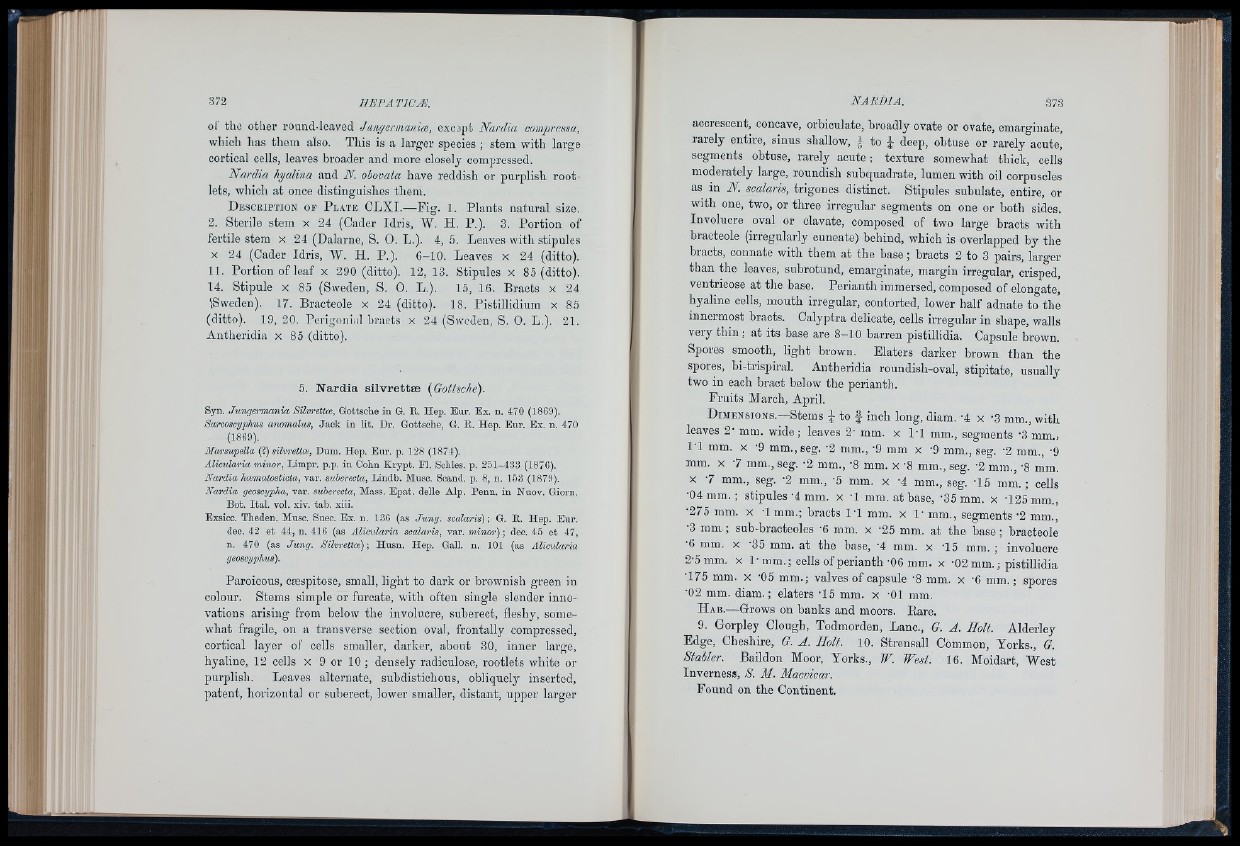
of the other rouad-leaved Jmigennanim, except Nardia compressa,
which has them also. This is a larger species ; stem with large
cortical cells, leaves broader and more closely compressed.
Nardia hyalina and N. obovata have reddish or purplish root
lets, which at once distinguishes them.
D escription op P late CLXI.—Pig. 1. Plants natural size.
2. Sterile stem x 24 (Cader Idris, W. H. P.). 3. Portion of
fertile stem x 24 (Dalarne, S. 0 . L.). 4, 5. Leaves with stipules
X 24 (Cader Idris, W. H. P.). 6-10. Leaves x 24 (ditto).
11. Portion of leaf x 290 (ditto). 12, 13. Stipules x 85 (ditto).
14. Stipule X 85 (Sweden, S. 0. L.). 15, 16. Bracts x 24
(Sweden). 17. Bracteole x 24 (ditto). 18. Pistillidium x 85
(ditto). 19, 20. Perigonial bracts x 24 (Sweden, S. 0. L.). 21.
Antheridia x 85 (ditto).
5. Nardia silvrettse [Gottsche).
Syn. .hmgermania SHnrettce, Gottsche in G. R. Hep. Bur. Ex. n. 470 (1869).
Sarcoscyphus anómalas. Jack in lit. Dr. Gottsche, G. E. Hep. Eur. Ex. n, 470
(1869).
Marsupella (f) silvrettca, Dum. Hep. Eur. p. 128 (1874).
Alicularia minor, Limpr. p.p. in Cohn Krypt. Fl. Schles. p. 251-433 (1876).
Nardia, hiemutosticta, var. sulerecta, Lindb. Muse. Scand. p. 8, n. 153 (1879).
Nardia geoscypha, var. suberecta, Mass. Ep a t. delle Alp. Penn, in Nuov. Giorn.
Bot. Ita l. vol. xiv. tab. xiii.
Exsicc. Theden. Muse. Suec. Ex. n. 186 (as Jung, scalaris); G. R. Hep. Eur.
dec. 42 e t 44, n. 416 (as Alicularia scalaris, var. minor); dec. 45 e t 47,
n. 470 (as Jung. Sihretioi); Husn. Hep. Gall. n. 101 (as Alicidas'ia
Paroicous, cæspitose, small, light to dark or brownish green in
colour. Stems simple or furcate, with often single slender innovations
arising from below the involucre, suberect, fleshy, somewhat
fragile, on a transverse section oval, frontally compressed,
cortical layer of cells smaller, darker, about 30, inner large,
hyaline, 12 cells x 9 or 10 ; densely radiculose, rootlets white or
purplish. Leaves alternate, subdistichons, obliquely inserted,
patent, horizontal or suberect, lower smaller, distant, upper larger
accrescent, concave, orhiculate, broadly ovate or ovate, emarginate,
rarely entire, sinus shallow, } to i deep, obtuse or rarely acute,
segments obtuse, rarely acute; texture somewhat thick, cells
moderately large, roundish suhquadrate, lumen with oil corpuscles
as in N. scalaris, trigones distinct. Stipules subulate, entire, or
with one, two, or three irregular segments on one or both sides.
Involucre oval or clavate, composed of two large bracts with
bracteole (irregularly cuneate) behind, which is overlapped by the
bracts, connate with them at the base ; bracts 2 to 3 pairs, larger
than the leaves, suhrotund, emarginate, margin irregular, crisped,
ventricose at the base. Perianth immersed, composed of elongate,
hyaline cells, mouth irregular, contorted, lower half adnate to thé
innermost bracts. Calyptra delicate, cells irregular in shape, walls
very thin ; at its base are 8-10 barren pistillidia. Capsule brown.
Spores smooth, light brown. Elaters darker brown than the
spores, bi-trispiral. Antheridia roundish-oval, stipitate, usually
two in each bract below the perianth.
Fruits March, April.
Dimensions.—Stems i to J inch long, diam. -4 x -3 mrn., with
leaves 2- mm. wide; leaves 2' mm. x IT mm., segments ‘3 mm.,
IT mm. X -9 mm., seg. ’2 mm., ‘9 mm x -9 mm., seg. '2 mm., '9
mm. X -7 mm., seg. -2 mm., '8 mm. x '8 mm., seg. '2 mm., '8 mm.
X -7 mm., seg. -2 mm., A mm. x '4 mm., seg. T5 mm. ; cells
•04 mm.; stipules-4 mm. x -1 mm. at base, -35 mm. x •125 mm.,
•275 mm. x -1 mm.; bracts 1-1 mm. x 1- mm., segments '2 mm.,
•3 mm.; sub-bracteoles -6 mm. x -25 mm. at the base; bracteole
•6 mm. x -35 mm. at the base, -4 mm. x -15 mra. ; involucre
2-5 mm. x 1‘mm.; cells of perianth-06 mm. x -02 mm. ; pistillidia
•175 mm. x -05 mm.; valves of capsule -8 mm. x -6 mm.; spores
•02 mm. diam.; elaters -15 mm. x -01 mm.
H ab.— Grrows on banks and moors. Eare.
9. Gorpley Clough, Todmorden, Lane., G. A. Holt. Alderley
Edge, Cheshire, G. A. Holt. 10. Strensall Common, Yorks., G.
Stabler. Baildon Moor, Yorks., W. West. 16. Moidart, West
Inverness, S. Al. Alacvicar.
Found on the Continent.